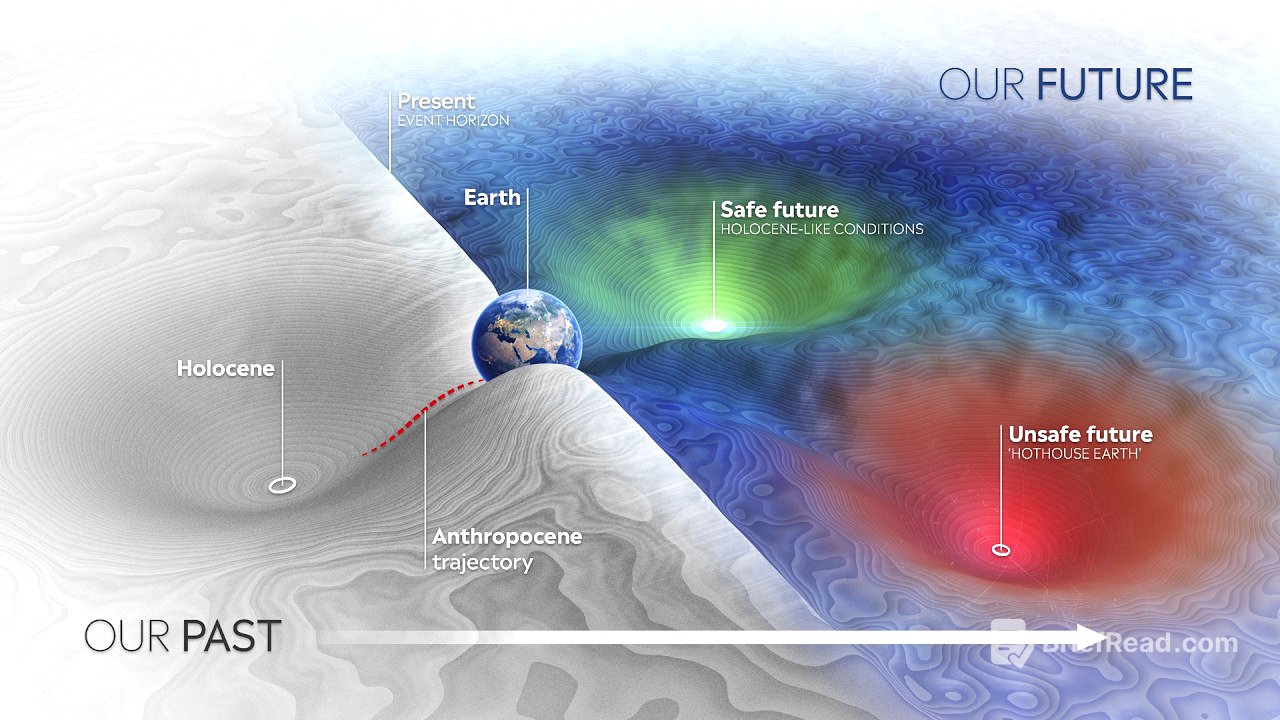TLDR;
The Earth system and climate scientists are increasingly concerned as the planet is changing faster than anticipated, with risks being underestimated. The planet has reached a critical point with accelerating warming, economic impacts, and the potential crossing of tipping points. To avoid unmanageable outcomes, immediate and drastic emission reductions are necessary, along with stewardship of the entire planet. Despite the dire situation, there is still a window of opportunity for transformation towards a sustainable future, driven by citizen concern and available solutions.
- The planet is warming at an accelerating rate, with potential for disastrous outcomes if current trends continue.
- Earth's buffering capacity is weakening, with land and ocean carbon sinks showing signs of strain.
- Crossing tipping points in major Earth systems could lead to self-amplifying warming and loss of life support.
- Staying within the global carbon budget requires immediate and drastic emission reductions.
- Solving the planetary crisis is not only necessary but also possible, with available solutions leading to a healthier, more stable future.
Introduction: A Scientific State of the Planet Report [0:07]
Earth system scientists are increasingly worried as the planet is changing faster than expected, with risks being underestimated. Despite years of warnings, the planet's situation is more critical than previously thought, with abrupt changes occurring beyond realistic scientific expectations. The speaker introduced the planetary boundary framework 15 years ago, highlighting nine Earth system processes crucial for the planet's stability and resilience. The world signed the Paris Climate Agreement 10 years ago, and five years ago, the decisive decade began, where choices will determine the future for all generations.
The Current State of Warming [1:08]
The planet has reached 1.2 degrees Celsius of global mean surface temperature rise, the warmest in 100,000 years, briefly touching 1.5 degrees Celsius in 2023. The acceleration of warming is a major concern, with a jump from 0.18 degrees Celsius per decade (1970-2010) to 0.26 degrees Celsius per decade (2014 onwards). Following this trajectory, the planet could exceed two degrees Celsius within 20 years and hit three degrees Celsius by 2100, a disastrous outcome caused by human activity. This trend extends beyond carbon dioxide levels, affecting parameters critical for human well-being and economies, including overconsumption of fresh water, the sixth mass extinction of species, and pollution of freshwater systems.
Economic and Social Costs [2:22]
The changes are causing significant impacts across the global economy, with increasing costs due to droughts, floods, heat waves, disease patterns, and human-reinforced storms attributed to climate change. In 2023, life-threatening heatwaves of 40 degrees Celsius occurred across continents, and 52 degrees Celsius was recorded during the Hajj pilgrimage in Mecca, resulting in over 1,000 deaths. Climate change risks are now three times higher, with the US alone incurring up to $200 billion in costs and 12,000 deaths in 2023. Scientific assessments indicate a potential 18% loss of global GDP by 2050 if the current path continues, equivalent to $38 trillion per year. These impacts are occurring at 1.2 degrees Celsius of warming, while the planet is on track for a 2.7 degrees Celsius increase in 70 years, far beyond the stable 14 degrees Celsius range that has supported human civilisation for the past 10,000 years.
Buffering Capacity and Tipping Points [4:43]
The Earth's buffering capacity, its ability to absorb shocks and stresses like greenhouse gases, is weakening. Intact nature on land and in the ocean has absorbed 53% of carbon dioxide from fossil fuel burning and land system change. However, there is increasing evidence of cracks in this system. Land, which absorbs 31% of carbon dioxide emissions, is losing its uptake capacity in boreal forests (Canada) and temperate mixed forests (Germany, Russia). The Amazon rainforest, the richest terrestrial biome, has already tipped over and is now a carbon source. The ocean, which absorbs 90% of the heat from human-induced climate change, is showing alarming sea surface temperature increases, particularly in 2023, with temperatures going completely off the charts by 0.4 degrees Celsius. The exact cause is unknown, but the energy imbalance caused by human activities is a primary suspect, raising concerns about the ocean's resilience and potential for self-amplifying warming.
Risk of Pushing the Planet Out of Balance [7:57]
There is a risk of pushing the planet out of its stable Holocene state towards a "hothouse Earth" with self-amplified warming and loss of life support. This could be triggered by crossing tipping points in systems like the Greenland ice sheet, the Atlantic Meridional Overturning Circulation (AMOC), coral reef systems, and the Amazon rainforest. These 16 scientifically catalogued tipping element systems, particularly those in the Arctic, are interconnected via cascades through the ocean, influencing the climate system. Five of these systems are likely to cross tipping points at 1.5 degrees Celsius, including the Greenland and West Antarctic ice sheets, abrupt thawing of permafrost, loss of tropical coral reefs, and collapse of Barents Sea ice. The two ice sheets alone hold ten metres of potential sea level rise, which would be unstoppable in the long term.
The Danger Zone and the Amazon Rainforest [10:16]
Scientific understanding has consistently shown increasing risks with each IPCC assessment over the past 30 years, with the danger zone now estimated at 1.5 to 2 degrees Celsius. The Amazon rainforest, the richest terrestrial ecosystem, faces a tipping point risk of converting to a savanna at 3 to 5 degrees Celsius of warming. However, if more than 20-25% of forest cover is lost, this tipping point could be reached at just 1.5 to 2 degrees Celsius. Currently, with 1.2 degrees Celsius of warming and 17% deforestation, the Amazon is very close to this critical threshold.
Pathways to Avoid Unmanageable Outcomes [11:56]
To stay under 1.5 degrees Celsius and avoid crossing tipping points, it is essential to operate within the global carbon budget, which currently allows for only 200 billion tons of additional carbon dioxide emissions. At the current emission rate of 40 billion tons per year, this budget will be consumed in just five years. A safe landing requires bending the emissions curve immediately, reducing emissions by at least 7% per year, and achieving a net-zero world economy by 2050. Even with these efforts, an overshoot of the 1.5-degree-Celsius limit is likely between 2030 and 2035, potentially reaching up to 1.8 degrees Celsius before returning to 1.5 degrees Celsius by the end of the century.
Messages and Planetary Boundaries [13:35]
The inevitable consequences of exceeding 1.5 degrees Celsius include more droughts, floods, heat waves, human-reinforced storms, and diseases. The year 2023, the warmest on record, will be considered mild in retrospect. To return to 1.5 degrees Celsius after the overshoot, the planet's health must be maintained, ensuring it can continue to absorb 50% of carbon dioxide, avoid crossing tipping points, and keep heat intact in the ocean. This requires adhering to planetary boundaries, which define the nine Earth system processes regulating the planet's stability and resilience: climate, biodiversity, nitrogen, phosphorus, land, fresh water, air pollutants, and chemicals. Achieving the Paris Agreement's 1.5 degrees Celsius target requires not only phasing out fossil fuels but also staying within the safe operating space of nature-based biodiversity and all planetary boundaries.
Opportunity for Transformation [15:11]
Despite the rapidly closing window, there is still an opportunity to transform the world towards a safe and just future. Linear change is no longer sufficient; exponential change is necessary, prioritising speed and scale. Stewardship of the entire planet, from local to global levels, is essential. The solutions are available for a secure and stable future, including a rapid transition away from fossil fuels, circular business models, healthy diets from sustainable food systems, and scaling the regeneration and restoration of marine systems, soils, forests, and wetlands. Green energy, now cheaper than fossil fuel-based energy, presents a viable alternative.
Realistic Optimism [16:45]
Although the road to cutting global emissions by half by 2030 is steeper than ever, there are reasons for realistic optimism. A majority of citizens worldwide care about nature and climate, trust climate science, are concerned about climate change, and want solutions. The solutions are not only available but also promise a healthier, more stable, and secure future with competitive economies and livelihoods. Solving the planetary crisis is both necessary and possible, with benefits for all.









